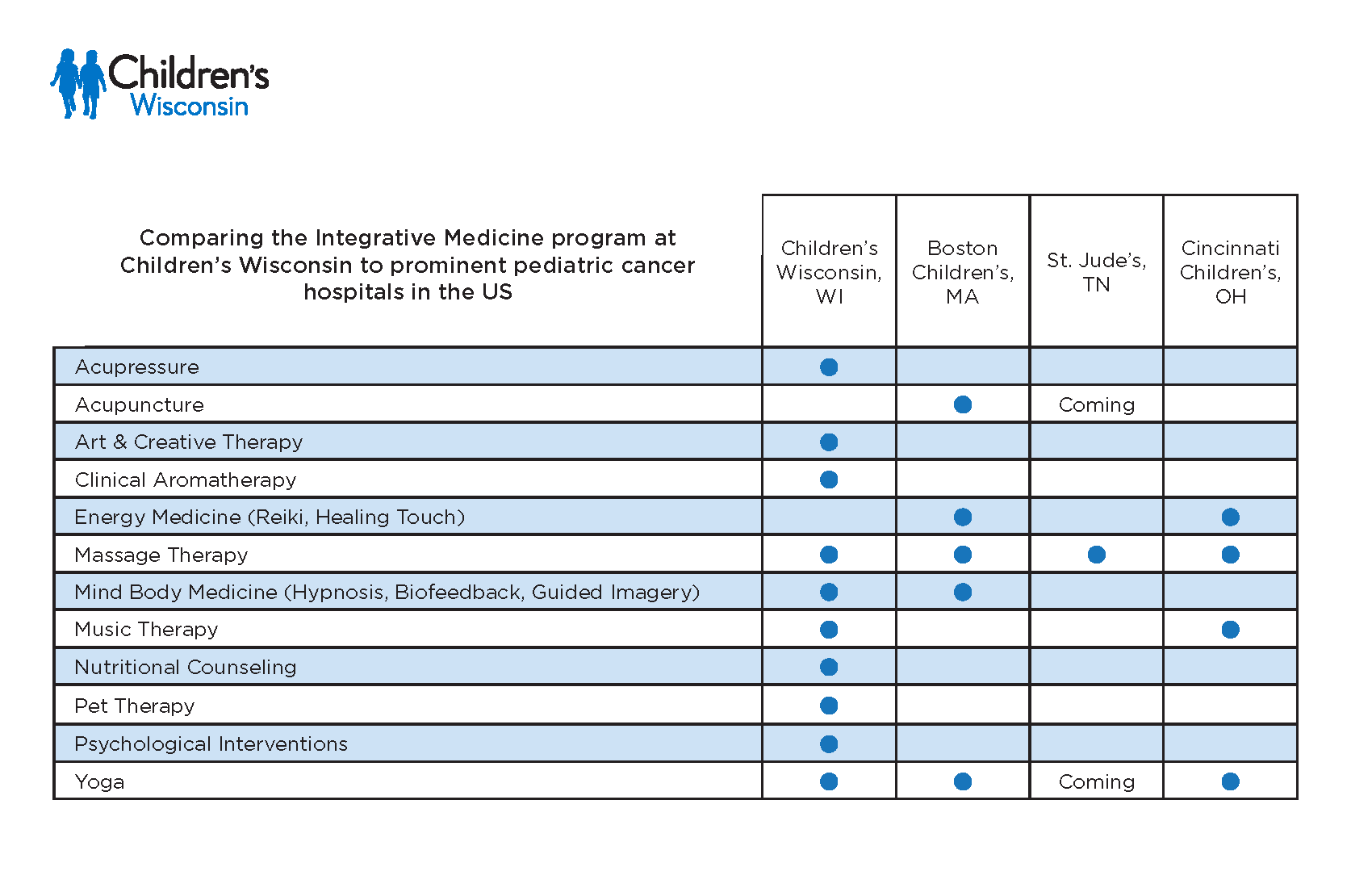Alternative, complementary and integrative medicine are ways of talking about non-standard care.
Scientists have studied standard care and found these treatments to be safe and effective. They have approval from the U.S. Food and Drug Administration (FDA) to treat a disease. These other types of care have not. Still, they may help support health, wellness and quality of life when used with standard care.
- Alternative medicine: Treatments used instead of standard medical care. At Children's Wisconsin, we do not advocate for alternative medicine.
- Complementary medicine: Alternative treatment in addition to standard medical care.
- Integrative medicine: Alternative treatment combined with standard treatments in a safe, coordinated way. This is what we do at Children's Wisconsin.
Some complementary medicine treatments include:
- Traditional medicine: Acupuncture, homeopathy, Chinese or oriental medicine, ayurveda and naturopathy.
- Healing by touch and movement: Chiropractic, massage, body movement, Tai chi and yoga.
- Diet, supplements and herbs: Attempts to improve well-being through supplements and herbs. Maintaining a healthy weight during therapy is very important, so getting nutritional guidance is key. Some herbs and supplements can be helpful for your child while going through therapy, while others can interfere with your child's chemotherapy. Our team is here to make unique recommendations based on each patient's individual diagnosis and treatment plan.
- External energy: Uses energy fields, like magnets or electromagnetic waves, to affect the body. Treatments don't involve touch or medicine.
- Connection between mind and body: Studies have found that people heal better if they have good emotional and mental health. Alternative therapies that claim to improve the mind-body connection include biofeedback and hypnosis.
- Engaging the senses: The senses of touch, sight, hearing, smell and taste can impact health. Therapies using senses include art, dance and music.
Always ask your child's care team before giving any treatment or supplement. Most of these fields are not standardized or controlled by any Western medical guidelines. When exploring these treatments, gather information before starting.
Consider:
- Asking your child's care team
- Looking at trusted sources on the Internet (hospital and government websites)
- Doing research in the library (books, articles and scientific journals)
- Asking others who have tried it
- Look for controlled, scientific studies about the therapy whenever possible
Beware these warning signs when learning about a therapy or care provider:
- It is based on unproven theories
- They promise a cure
- They dismiss or tell you to stop standard care
- It is a secret, and only they can give the treatment
- You need to travel to another country for it
Navigating facts from truth in complementary medicine is stressful. You can trust that our care teams are always looking out for you and your family. When we asked, nearly 90% of our families wanted to explore these types of therapies. Our team listened and created the Integrative Medicine Program.
We employ a range of evidence-based, non-invasive therapies in a safe and controlled way. We work to alleviate pain and discomfort during cancer and blood disorder care.
The Integrative Medicine Program at the MACC Fund Center offers:
- Acupressure: Uses ancient Chinese medicine principles to increase the flow of energy, known as qi. It's similar to acupuncture, but instead of needles, the technician gives gentle pressure with their hands. Research shows it can help treat pain and nausea. We can also teach you these pressure points.
- Aromatherapy: Smelling essential oils can induce relaxation through the body's nervous system. Aromatherapy can be a simple tool to reduce anxiety and nausea.
- Nutritional counseling: Good nutrition can help your child feel more energized. Our dieticians can provide resources and diet advice. We want to help your child feel their best.
- Naturopathic oncology: This specialized filed combines a deep understanding of cancer biology with natural and supportive therapies to help address the unique needs of children and adolescents undergoing treatment. It is integrated into the MACC Fund Center for Cancer and Blood Disorders to complement conventional pediatric cancer treatment with evidence-based, holistic approaches using safe, research-informed interventions such as nutrition therpay, herbal medicine, homeopathy and mind-body practices.
We partner with the Children's Wisconsin Child Life Program to offer:
- Art therapy: Kids use drawing, painting and crafts to express feelings. It can help them cope.
- Music therapy: Singing, listening to music or playing instruments helps kids relax.
- Recreational therapy: Fun games and activities help kids stay active and build confidence.
- Therapy dogs: Specially trained dogs visit to bring comfort, smiles and stress relief.





